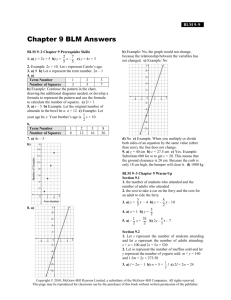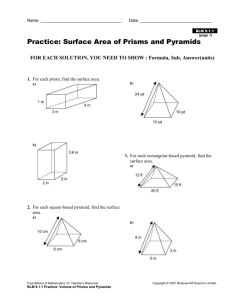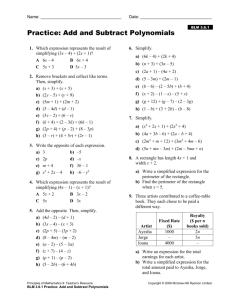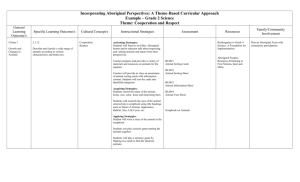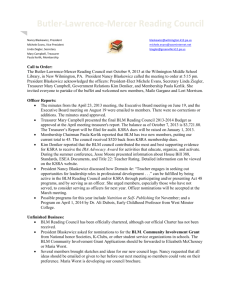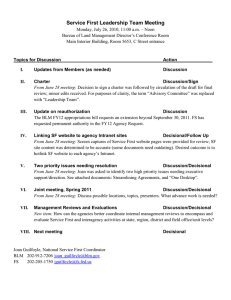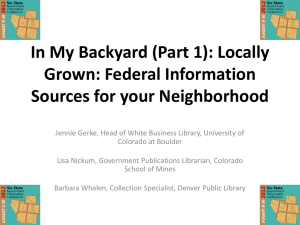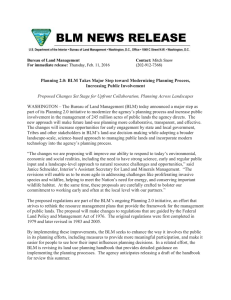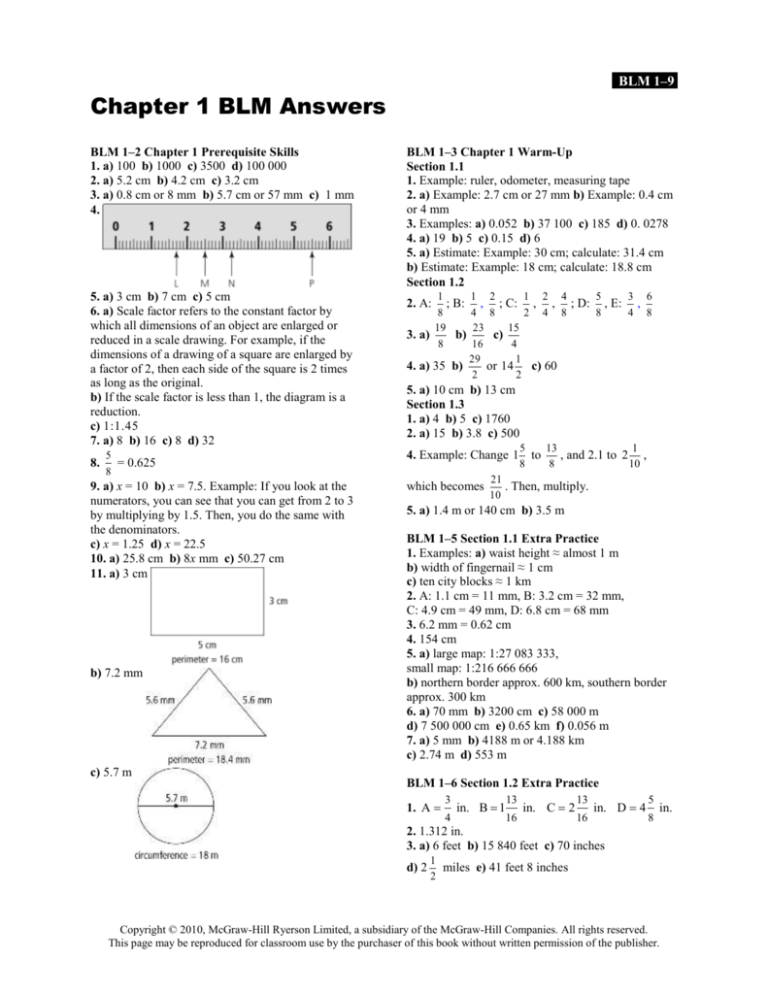
BLM 1–9
Chapter 1 BLM Answers
BLM 1–2 Chapter 1 Prerequisite Skills
1. a) 100 b) 1000 c) 3500 d) 100 000
2. a) 5.2 cm b) 4.2 cm c) 3.2 cm
3. a) 0.8 cm or 8 mm b) 5.7 cm or 57 mm c) 1 mm
4.
5. a) 3 cm b) 7 cm c) 5 cm
6. a) Scale factor refers to the constant factor by
which all dimensions of an object are enlarged or
reduced in a scale drawing. For example, if the
dimensions of a drawing of a square are enlarged by
a factor of 2, then each side of the square is 2 times
as long as the original.
b) If the scale factor is less than 1, the diagram is a
reduction.
c) 1:1.45
7. a) 8 b) 16 c) 8 d) 32
8.
5
= 0.625
8
9. a) x = 10 b) x = 7.5. Example: If you look at the
numerators, you can see that you can get from 2 to 3
by multiplying by 1.5. Then, you do the same with
the denominators.
c) x = 1.25 d) x = 22.5
10. a) 25.8 cm b) 8x mm c) 50.27 cm
11. a) 3 cm
b) 7.2 mm
c) 5.7 m
BLM 1–3 Chapter 1 Warm-Up
Section 1.1
1. Example: ruler, odometer, measuring tape
2. a) Example: 2.7 cm or 27 mm b) Example: 0.4 cm
or 4 mm
3. Examples: a) 0.052 b) 37 100 c) 185 d) 0. 0278
4. a) 19 b) 5 c) 0.15 d) 6
5. a) Estimate: Example: 30 cm; calculate: 31.4 cm
b) Estimate: Example: 18 cm; calculate: 18.8 cm
Section 1.2
1
; B:
8
19
3. a)
b)
8
1 2
1 2 4
5
3 6
, ; C: , , ; D: , E: ,
4 8
2 4 8
8
4 8
23
15
c)
16
4
1
29
4. a) 35 b)
or 14 c) 60
2
2
2. A:
5. a) 10 cm b) 13 cm
Section 1.3
1. a) 4 b) 5 c) 1760
2. a) 15 b) 3.8 c) 500
5
8
4. Example: Change 1 to
which becomes
13
1
, and 2.1 to 2 ,
8
10
21
. Then, multiply.
10
5. a) 1.4 m or 140 cm b) 3.5 m
BLM 1–5 Section 1.1 Extra Practice
1. Examples: a) waist height ≈ almost 1 m
b) width of fingernail ≈ 1 cm
c) ten city blocks ≈ 1 km
2. A: 1.1 cm = 11 mm, B: 3.2 cm = 32 mm,
C: 4.9 cm = 49 mm, D: 6.8 cm = 68 mm
3. 6.2 mm = 0.62 cm
4. 154 cm
5. a) large map: 1:27 083 333,
small map: 1:216 666 666
b) northern border approx. 600 km, southern border
approx. 300 km
6. a) 70 mm b) 3200 cm c) 58 000 m
d) 7 500 000 cm e) 0.65 km f) 0.056 m
7. a) 5 mm b) 4188 m or 4.188 km
c) 2.74 m d) 553 m
BLM 1–6 Section 1.2 Extra Practice
1. A
3
4
in. B 1
13
16
in. C 2
13
16
in. D 4
5
8
in.
2. 1.312 in.
3. a) 6 feet b) 15 840 feet c) 70 inches
d) 2
1
miles e) 41 feet 8 inches
2
Copyright © 2010, McGraw-Hill Ryerson Limited, a subsidiary of the McGraw-Hill Companies. All rights reserved.
This page may be reproduced for classroom use by the purchaser of this book without written permission of the publisher.
BLM 1–9
(continued)
3
1
miles b) 3 inches
8
2
1
5. a) 340 inches b) 34 inches
2
1
6. perimeter = 20 feet
2
1
1
1
7
7. a) 7 in. b) 1.875 = 1 c) 7 in. by 11 in.
2
2
4
8
4. a) 5
BLM 1–7 Section 1.3 Extra Practice
1. a) 4000 mi b) 0.1 mm c) 18.44 m d) 296 km
1
2
2. 96 inches by 151 inches ; 244 cm by 385 cm
3. a) Estimate: 45 ft = 15 × 3. Actual answer is
greater because 17 > 15.
b) Example: metre c) 15.5 m
1
4. a) centimetres b) 3.0 cm = 1 inch
4
c) 1:3.33 cm
5. 627 km = 390 mi
6. a) 12
1
1
ft by 13 ft b) 52 feet
2
2
c) 5 lengths
BLM 1–8 Chapter 1 Test
1. C 2. A 3. C 4. D 5. C 6. 35 7. 8
8. 2 ft
9. a) 514.3 m b) 2.65 m c) 54 cm
1
4
1
12. a) 9.5 km b) 1920 cm c) 54 in. d) 5 yd
2
13. 55 in.
14. a) 800 cm or 8 m
b) 12 m by 18 m
c) estimate: 5.5 cm
d) Method 1: Measure the length of the diagonal in
the diagram or use the Pythagorean theorem to
calculate the length of the hypotenuse in the drawing.
Then, use the scale to calculate the actual distance.
5.4 cm
1
=
x
400
Method 2: Use the measurements calculated
in part b) and apply the Pythagorean theorem.
x 2160 cm or 21.6 m
x 2 122 182
x 2 144 324
x 2 468
x 21.6 m
1
4
15. a) estimate: 1 in.
b) referent: width of 1 fingernail 1 cm
estimate: 3 cm
1
5
c) 3 cm = 1 in. Estimate is slightly greater than
measurement.
d) 40.5 cm
10. a) 5 ft b) 252 in.
11. a) 1 mi 1.609 km
b) 1 m = 100 cm
c) 12 in. = 1 ft
d) 100 cm = 1 m and 1 yd = 0.9144 m
Copyright © 2010, McGraw-Hill Ryerson Limited, a subsidiary of the McGraw-Hill Companies. All rights reserved.
This page may be reproduced for classroom use by the purchaser of this book without written permission of the publisher.


